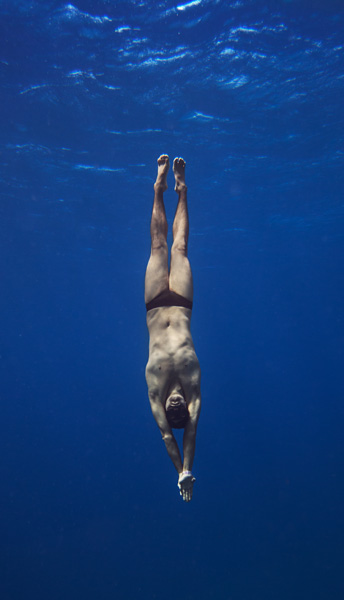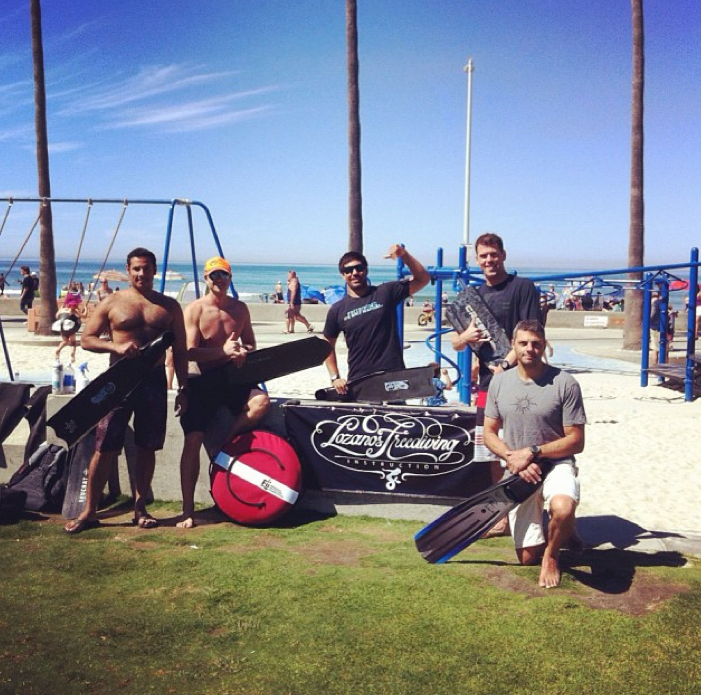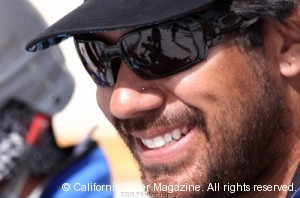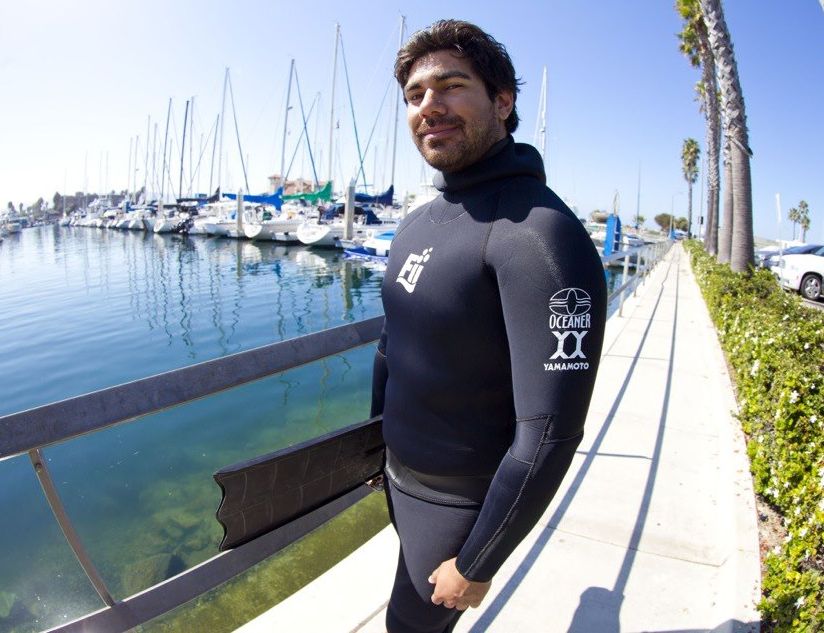The theory of evolution claims that all land animals evolved from the sea. Some of them went inland, away from the ocean shorelines, while others, like humans, stayed close to the familiar and life giving waters. As we evolved more and more into land animals, we maintained a very important aquatic adaptation known as The Mammalian Diving Reflex – a reflex that is shared by seals, sea lions, whales, dolphins, manatees, and any other sea mammals you can think of. The MDR is what enables us to hold our breath for extended periods of time under water and dive to incredible depths.
No one is born a naturally gifted freediver; they must be taught the proper technique if they wish to safely hold their breath for extended periods, or safely dive to deeper depths. That’s where highly trained instructors, like those of Freediving Instructors International, come in. F.I.I. was started by world champion freediver Martin Stepanek, whose first world record was a static breath hold of 8 minutes and 6 seconds in 2001, and in 2009 became the first man to swim to a depth of 400 feet (122m).
F.I.I. has a standardized education system, and offers three main courses, instructor courses and several specialty courses, such as Basic Freediving Safety and Introduction to Monofin. The two day, Level 1 Freediver, course goes over the basics of freediving, giving the student the tools to safely hold his/her breath for up to three minutes, and dive to a maximum depth of 66 feet (20m). The four day, Level 2 Freediver, course teaches the student how to safely unlock his/her physiological potential. The average student finishes this course with a breath hold of 3-1/2 to 5 minutes, and comfortably reaching depths of 80 to 100 feet. The four day, Level 3 Freediver, course is held for Level 2 certified freedivers wishing to learn how to change their physiology in order to become better divers, and has been deemed the ultimate experience for the dedicated freediver.
Story by Mark Lozano, Freediving Instructors International Instructor
Getting started is easy; grab a mask, snorkel, and a buddy. Find the closest body of water, and jump in. Fins are optional! Welcome to the wonderful world of apnea diving. As freedivers we rely heavily on our gear choices. Masks need to be equalized, suits need to keep us warm and help us conserve precious oxygen, and fins need to be as efficient as possible. With so many options available to us on the market, how do we decide what’s treasure and what’s trash? 
The most important piece of gear we will own will be our wetsuit. The breathing techniques we use slow our heart rate so much that our body barely produces any heat, so it’s important to choose wisely. The best freediving suits are very flexible, have an attached hood, and have open cells on the inside of them, or some sort of smooth bio-thermic lining. This keeps the suits practically water tight and well-fitted once donned. Closed cell wetsuits do not seal as well, and allow for water to flow in and out of the suit. A good 5mm freediving suit provides the equivalent warmth as an 8mm SCUBA suit.
A good foot pocket for our fins is the next important piece of equipment. We need to make sure to check for strength of the heel cup, to be sure that we do not lose kick power to our fins, otherwise we will consume more oxygen. A strong comfortable foot pocket is what you are looking for in a good freediving fin. There are several options for fin materials, the most common being plastic, fiberglass, and carbon fiber. Plastic is a great entry fin blade; throw it against the rocks, step on it on the boat, or even leave it baking in the sun, and it will remain pretty much unharmed.
Our next option is fiberglass. This material is considered the workhorse of the fin blades; they are extremely durable, and very efficient. They offer better performance without much of a price increase. Another advantage to fiberglass is that they come in different levels of stiffness, softer for easy surface swimming, stiffer for deeper, more efficient dives. Carbon Fiber is the best fin material available, also available in different levels of stiffness, with incredible snap and ease of use. If you’re primarily a boat diver, these are the blades for you. Overall, plastic blades are great if you’re on a tighter budget.
Fiberglass blades are closer in performance to carbon fiber, and closer to the price of plastics. The Captain Nemo’s are some of the best and least expensive, on the market. C4 is responsible for making some of the most outstanding carbon fiber blades available in the world, but take care of these, and don’t let disgruntled baggage handlers get hold of them on your next trip to Hawaii.
Our mask choice will be determined in part by the amount of air we pull from our lungs and put into our mask to equalize the airspace. There are a few important things to look at when considering a mask; first and foremost it should fit properly. Secondly, it should be as low volume as possible, to make equalizing it underwater easy and efficient. The third thing to consider is how much field of view would you like. Clear lenses are always recommended over tinted lenses. Snorkels are simple: less is more. We don’t need a dry or semi dry snorkel, a flexy tube, or even purge valves, we spit the snorkel out as soon as our head goes underwater, and the more streamlined we are, the less oxygen we are consuming. The most efficient place to attach our snorkel is to the back of our mask strap.  Rubber weight belts are great because we can pre-stretch them around our hips, and not have to readjust them at depth due to wetsuit compression. Small weights, such as one or two pounders, are always best for efficient streamlining and accurate buoyancy setting.
Rubber weight belts are great because we can pre-stretch them around our hips, and not have to readjust them at depth due to wetsuit compression. Small weights, such as one or two pounders, are always best for efficient streamlining and accurate buoyancy setting.
Take a freediving class! Click here for a schedule of Mark’s upcoming Freediving classes
A depth gauge is helpful, since we always like to brag to our friends about how deep we can dive and how long we can hold our breath. We may also want to keep track of our surface intervals, or even our depths during the day. Wouldn’t it be nice to not even have to look at the gauge to know when you’re at certain depths, breath hold times, or surface intervals? The Aeris F10 does all of that, and even has a chronograph. It is a freediving specific computer that enters “wet” mode as soon as it touches the water, and goes into “freedive” mode as soon as it goes five feet underwater. It keeps a log of your dives throughout the day, and you can even upload your logbook to your PC.
The F10 is not the only freediving computer on the market, but for now it stands tall among the rest. There are many health benefits to freediving, since we rely so heavily on our body as our primary gauge, we begin to take better care of ourselves. It helps to release stress, and calm our mind and body. Animal interactions become more personal and more playful. It’s been said that when we go underwater with SCUBA, we dive down to look around. When we dive underwater on a single breath of air, we dive down to look within ourselves. To read more articles on freediving, click here. http://www.youtube.com/watch?v=IWBaZo0a4r8
 Mark Lozano earned his PADI Open Water SCUBA certification at the age of 15. Shortly thereafter he discovered freediving, which quickly became another passion. He trained with world freediving champion Martin Stepanek, the first man to successfully freedive pass 400ft (122m), and founder of Freediving Instructors International. There, Mark earned the designation of an F.I.I. Level 1, 2, and Basic Freediving Safety Instructor.
Mark Lozano earned his PADI Open Water SCUBA certification at the age of 15. Shortly thereafter he discovered freediving, which quickly became another passion. He trained with world freediving champion Martin Stepanek, the first man to successfully freedive pass 400ft (122m), and founder of Freediving Instructors International. There, Mark earned the designation of an F.I.I. Level 1, 2, and Basic Freediving Safety Instructor.
All content ©2014 by the author and California Dive Magazine and may not be reproduced without express permission. . .

